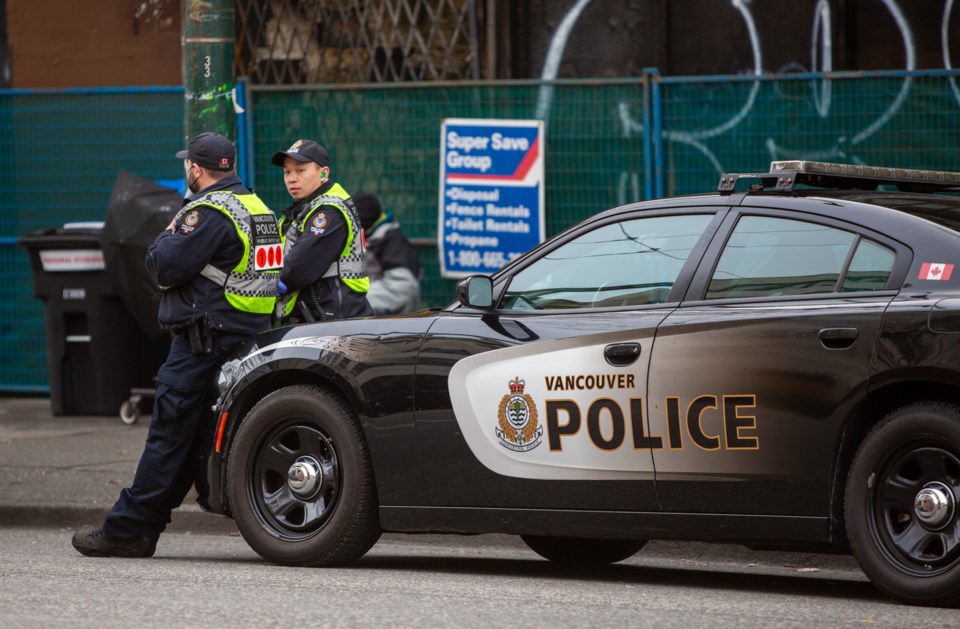The Vancouver Police Department has seen a significant drop in the number of abandoned calls to its non-emergency line but is concerned an estimated 40,000 calls from citizens will still go unanswered before the end of the year.
New data from the department shows there were 20,410 abandoned calls recorded in the first half of the year, which is down about 57 per cent from the same period in 2022 when totals reached 47,778.
The improvement was noted by VPD in a recent crime data report to the Vancouver Police Board but so was the fact abandoned non-emergency calls are still in the thousands, despite efforts by E-Comm to improve the service.
“If this trend continues into the latter half of the year, it is projected that approximately 40,000 calls from the public will go unanswered,” the report said. “While this is an improvement from the first half of 2022, it remains higher than the historical baseline.”
The issue has been a concern raised repeatedly by Police Chief Adam Palmer, deputy chiefs and police board members, noting the abandoned calls don’t reflect the true level of crime in Vancouver.
1,700 reports of break-ins
In a presentation to the police board more than a year ago, Simon Demers, the VPD’s director of planning, research and audit section, said the department’s analysis of 88,000 abandoned calls in 2021 suggested there would have been an additional 1,700 reports of break-ins to homes and businesses last year.
Added to those crime reports would have been 1,000 thefts, 600 assaults, 500 calls related to mischief and 200 for fraud, said Demers, whose report focused on the “crime severity index” in Vancouver, which remains higher than the national average.
A police report that went before the board earlier this year said abandoned calls not only negatively impact residents but also damages the reputation of police departments serviced by E-Comm.
“Callers often do not distinguish E-Comm from the police department they are trying to reach,” the report said. “This leads to the under-reporting of crime and an underestimation of the actual demand for policing in Vancouver, or the amount of police resources required to adequately address crime concerns.”
'Digital agent'
The decrease in abandoned calls this year has naturally translated to increased police calls for service. That increase is at more than 9,000 calls, meaning more officers tied up in the field, leading to longer response times including for emergencies.
The VPD believes a 7.6 per cent increase in property crime reports during the first half of the year are connected to more people successfully getting through the non-emergency line.
The VPD attributes the decrease in abandoned calls to a project E-Comm implemented in May involving artificial intelligence technology. Callers to the non-emergency line had the option of connecting with a “digital agent.”
“The digital agent interacts with callers in a conversational manner to gather or provide information, and route calls accordingly,” said a recent report to the police board.
“This has successfully redirected many calls to other information resources, helping callers get faster answers and allowing call-takers to prioritize calls requiring a human response.”
The VPD is the test agency in B.C. for this technology and will likely be expanded to other jurisdictions in the province.
'Rounded the corner'
E-Comm has acknowledged the concerns of the Vancouver police and other departments, most recently in a July letter to police board member Patricia Barnes, who is also president of the BC Association of Police Boards.
“There is no question that E-Comm’s performance in police non-emergency call-taking had deteriorated to levels that were unacceptable to all of us, including our board of directors, executive leadership team, and police agency partners, and that urgent action was needed to address this,” wrote Doug Campbell, chairperson of E-Comm’s board of directors.
That action has resulted in a “transformation plan” that has led to more non-emergency calls being answered, said Campbell, who pointed out 68 per cent of calls in the Lower Mainland were being answered within three minutes.
That is an improvement from 41 per cent in 2022.
“It is important to note these results have been achieved in spite of a significant 23 per cent increase in 911 call volumes from January to June this year compared to the same period in 2022,” Campbell said.
“These increases are a challenge for us all, including our police agency partners, and underscore the ongoing importance of the transformation plan funding and initiatives now underway.”
He said the E-Comm board of directors is confident that the organization is now executing a comprehensive plan to strengthen its operations and rebuild police confidence “and has now rounded the corner to a more stable path for the future.”
Last year, the City of Vancouver paid E-Comm $24 million to provide dispatch services for police and fire departments, with $20 million for the police portion.
The city also contributes to a regional fund via the Metro Vancouver agency that pays for the call-taking portion of 911 ambulance calls, which get transferred to BC Emergency Health Services.
The regional fund totalled $4.2 million in 2020.




